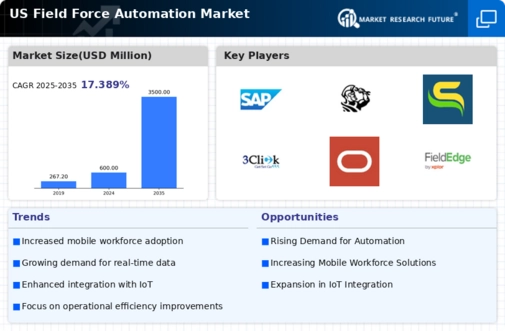Integration of IoT Technologies
The integration of Internet of Things (IoT) technologies is emerging as a key driver in the field force-automation market. IoT devices facilitate real-time monitoring and data collection, which can significantly enhance decision-making processes in field operations. For instance, companies utilizing IoT-enabled field force automation solutions can achieve a reduction in downtime by approximately 15%. This capability is particularly advantageous in sectors such as manufacturing and logistics, where equipment performance is critical. As the adoption of IoT technologies continues to rise, the field force-automation market is poised for growth, driven by the need for smarter and more connected field operations.
Advancements in Mobile Technology
The field force-automation market is significantly influenced by advancements in mobile technology. The proliferation of smartphones and tablets has enabled field workers to access real-time data and applications, thereby enhancing their productivity. Recent statistics indicate that mobile solutions can improve response times by up to 30%, which is crucial for industries that rely on immediate customer service. Furthermore, the integration of mobile technology with field force automation tools allows for seamless communication between field agents and back-office staff. This trend is expected to propel the market forward as organizations seek to leverage mobile capabilities to enhance their field operations.
Growing Emphasis on Customer Experience
In the field force-automation market, there is an increasing emphasis on enhancing customer experience. Companies are recognizing that efficient field operations directly impact customer satisfaction and retention. Data suggests that organizations that utilize field force automation tools can improve customer satisfaction scores by as much as 25%. This focus on customer-centric approaches is driving investments in automation technologies that enable faster service delivery and better communication with clients. As businesses strive to differentiate themselves in competitive markets, the field force-automation market is likely to benefit from this shift towards prioritizing customer experience.
Increased Focus on Workforce Management
The field force-automation market is witnessing a heightened focus on effective workforce management. Organizations are increasingly investing in automation solutions that enable better scheduling, resource allocation, and performance tracking of field personnel. Recent findings indicate that companies implementing workforce management tools can enhance employee productivity by up to 20%. This trend is particularly relevant in industries such as construction and maintenance, where efficient workforce management is essential for project success. As businesses seek to optimize their human resources, the field force-automation market is likely to expand, driven by the demand for sophisticated workforce management solutions.
Rising Demand for Operational Efficiency
The field force-automation market is experiencing a notable surge in demand for operational efficiency across various sectors. Organizations are increasingly recognizing the need to streamline their field operations to reduce costs and enhance productivity. According to recent data, companies that have implemented field force automation solutions report an average increase of 20% in operational efficiency. This trend is particularly evident in industries such as telecommunications and utilities, where timely service delivery is critical. As businesses strive to optimize their resources, the field force-automation market is likely to see continued growth, driven by the necessity for improved workflows and reduced operational bottlenecks.
























Leave a Comment